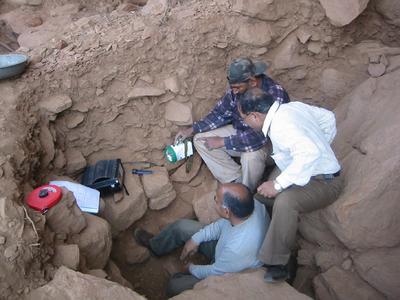Minister’s speech
Speech of the Minister of Culture, Agra 28 Nov. 2004
Robert G. Bednarik auranet@optusnet.com.au
 Measuring background radiation for OSL dating, Acheulian strata, Daraki-Chattan, 10 December 2004. The boulder in the foreground, on which the man on the right has placed his foot, bears one in-situ cupule, and there are two more cupules on the exfoliated slab just below the electric torch, centre of image.
|
I extend a warm welcome to the delegates of the RASI-2004 International Rock Art Congress, Agra organized by the Rock Art Society of India in collaboration with the Indira Gandhi Rashtriya Manav Sangrahalaya, Bhopal, and the Indira Gandhi National Centre for the Arts, New Delhi.
Rock art forms the earliest manifestation of human visual creations. It is a global phenomenon. It can serve as a tool for developing a better understanding and a spirit of cooperation and peaceful relations among the people of the world. From this perspective alone it becomes makes good sense to give emphasis on the scientific research on rock art.
India is one of the three countries having the richest treasures of rock art in the world. The Bhimbetka complex of rock shelters discovered by Dr V.S. Wakankar near Bhopal in 1957 has been declared a World Heritage site by UNESCO in July 2003. But now there is a new development to be reported, the work and results of an international team of researchers called the Early Indian Petroglyphs Project. It is a source of much personal satisfaction for me to endorse the work of this successful team, which has just demonstrated the incredibly ancient origins of culture in India.
We have long been accustomed to hearing about the sophistication of Indian culture in historic times, but the research team working on the early rock art of Madhya Pradesh has shown that this distinction does not extend back just thousands of years, or even tens of thousands of years. It can be traced back hundreds of thousands of years. Until now, most archaeologists in the world had believed that humans still lacked language at that stage of their development. The scientists who have now shown that the earliest known rock art in the world is in central India have overnight changed the landscape of global cultural evolution. They have also drawn attention to the enormous research potential in this field. I applaud their work and their dedication.
My enthusiasm for these sensational results prompts me to suggest that it is time for the Archaeological Survey of India to establish a special section dealing specifically with prehistoric rock art and with the Palaeolithic period of India, the Older Stone Age. Agencies to address such topics as the study, conservation and protection of rock art should perhaps also be formed in the IGNCA and IGRMS. These subjects will become increasingly important as the world focuses its attention on the very early cultural development in India.
Similarly, I propose that the protection of the sites in question be considered adequately. I understand that in the order of twenty sites are at present known in a small area near Gandhi Sagar in Mandsaur district, Madhya Pradesh, all of which may form part of this very earliest art evidence. This is a remote area and it should be possible to establish a National Park for their preservation and management. That potential needs to be investigated immediately. The research team must be provided with the means to complete its important survey, excavation and dating work, which is the ultimate source of this newfound pride in the ancient cultures of India. Places of such importance as the oldest art sites in the world are national shrines; they are to be well protected and looked after. I consider it to be our obligation to preserve what is left of the cultural heritage of India, which we now know extends back further in time than that of any other region of the world.
The ongoing Early Indian Petroglyphs Project is one of the best examples of international cooperation and scientific spirit in this field. It is a joint venture of the Rock Art Society of India, the Australian Rock Art Research Association, the Archaeological Survey of India and the Indian Council of Historical Research, and many scientific laboratories in India and Australia, including the Institute of Physics, Bhubneswar. It is testing the antiquity of the earliest known rock art in the world, found in Daraki-Chattan Cave in Chambal valley and in the Auditorium Cave at Bhimbetka. Their antiquity extends back five to ten times as far as that of oldest European rock art, which is nearly 33,000 years old.
I endorse this work fully and I pledge my ministry’s support for this outstanding project. It is a source of personal and national pride that India has so suddenly emerged as a leading country in this area of scientific endeavour.
Shri S. Jaipal Reddy
Union Minister of Information, Broadcasting and Culture